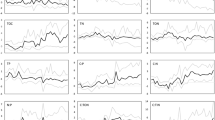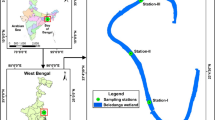Abstract
Water chemistry and surface sediments were analyzed from 41 shallow lakes representing three previously-defined hydrological categories in the Slave River Delta, Northwest Territories, Canada, in order to identify relationships between hydrological and limnological conditions and their associations with recently deposited diatom assemblages. Evaporation-dominated lakes are physically removed from the influence of the Slave River, and are characterized by high alkalinity and high concentrations of nutrients and ions. In contrast, flood-dominated lakes tend to receive a pulse of floodwater from the Slave River during the spring thaw and have low alkalinity and low concentrations of most nutrients and ions. Exchange-dominated lakes are variably influenced by floodwaters from the Slave River and seiche events from Great Slave Lake throughout the spring thaw and open-water season, and are characterized by a broad array of limnological conditions that are largely dependent on the strength of the connection to these sources of floodwater. Specific diatom ‘indicator’ taxa have been identified that can discriminate these three hydrological lake categories. Evaporation-dominated lakes are associated with high relative abundance of common epiphytic diatom taxa, while diatoms indicative of flood- and exchange-dominated lakes span a wide range of habitat types (epiphytic, benthic) but also include unique planktonic diatoms (Stephanodiscus and Cyclostephanos taxa) that were not found in surface sediments of evaporation-dominated lakes. The planktonic diatom taxa originate from the Slave River, and thus are indicative of river influence. In complex, remote, freshwater ecosystems like the Slave River Delta, integration of results from hydrological and limnological approaches provides a necessary foundation to assess present, past and future hydroecological responses to changes in river discharge and climate.






Similar content being viewed by others
References
Birks HJB (1995) Quantitative paleoenvironmental reconstructions. In: Maddy D and Brew JS (eds) Statistical modeling of Quaternary science data. Quaternary Research Association Technical Guide No. 5, Cambridge, pp 161–254
Birks HJB, Webb III T, Berti AA (1975) Numerical analysis of pollen samples from central Canada: a comparison of methods. Rev Palaeobot Palynol 20:133–169
Brock BE, Wolfe BB and Edwards TWD (2007) Characterizing the hydrology of shallow floodplain lakes in the Slave River Delta, NWT, using water isotope tracers. Arct Antarct Alp Res (in press)
Clarke KR, Warwick RM (2001) Changes in marine communities: an approach to statistical analysis and interpretation (2nd edn). Plymouth Marine Laboratory, Plymouth, UK, 144 pp
English MC, Hill RB, Stone MA, Ormson R (1997) Geomorphological and botanical change on the outer Slave River Delta, NWT, before and after impoundment of the Peace River. Hydrol Proc 11:1707–1724
Environment Canada (1996) Manual of analytical methods. The national laboratory of environmental testing, Canada Centre for Inland Waters, Burlington
Glew JR (1991) A miniature gravity corer for recovering short sediment cores. J Paleolimnol 5:285–287
Hall RI, Smol JP (1996) Paleolimnological assessment of long-term water-quality changes in south-central Ontario lakes affected by cottage development and acidification. Can J Fish Aquat Sci 53:1–17
Hall RI, Wolfe BB, Edwards TWD, Karst-Riddoch TL, Vardy SR, McGowan S, Sjunneskog C, Paterson A, Last WM, English M, Sylvestre F, Leavitt PR, Warner BG, Boots B, Palmini R, Clogg-Wright KP, Sokal MA, Falcone M, van Driel P and Asada T (2004) A multi-century flood, climatic, and ecological history of the Peace-Athabasca Delta, northern Alberta, Canada. Final report. Published by BC Hydro, pp 163 + Appendices
Hay MB, Smol JP, Pipke KJ, Lesack LWF (1997) A diatom-based paleohydrological model for the Mackenzie Delta, Northwest Territories, Canada. Arct Alp Res 29:430–444
Hay MB, Michelutti N, Smol JP (2000) Ecological patterns of diatom assemblages from Mackenzie Delta lakes, Northwest Territories, Canada. Can J Bot 78:19–33
Hill MO (1973) Diversity and evenness: a unifying notation and its consequences. Ecology 54:427–432
Jeffrey SW, Mantoura RFC, Wright SW (1997) Phytoplankton Pigments in Oceanography: guidelines to Modern Methods. UNESCO Publishing, Paris, pp 661
Junk WJ (2005) Flood pulsing and the linkages between terrestrial, aquatic and wetland systems. Verh Internat Verein Limnol 29:11–38
Krammer K, Lange-Beralot H (1986–1991) Bacillariophyceae. In: Ettl H, Gerloff J, Heynig H, Mollenhauer D (eds) Sϋβwasserflora von mitteleuropa band 2/1–4. Gustav Fischer Verlag, Stuttgart
Lesack LFW, Marsh P, Hecky RE (1998) Spatial and temporal dynamics of major solute chemistry among Mackenzie Delta lakes. Limnol Oceanogr 43:1530–1543
Lewis Jr WM, Hamilton SK, Lasi MA, Rodriguez M, Saunders III JF (2000) Ecological determinism on the Orinoco floodplain. BioScience 50:681–692
Michelutti N, Hay MB, Lesack LFW, Smol JP (2001) Diatom changes in lake sediments from the Mackenzie Delta, N.W.T., Canada: paleohydrological applications. Arc Antarc Alp Res 33:1–12
Milburn D, Prowse TD (1998) Sediment bound contaminants in a remote northern delta. Nord Hydrol 29:397–414
Nilsson C, Reidy CA, Dynesius M, Revenga C (2005) Fragmentation and flow regulation of the world’s large river systems. Science 308:405–408
Overpeck J, Hughen K, Hardy D, Bradley R, Case R, Douglas M, Finney B, Gajewski K, Jacoby G, Jennings A, Lamoureux S, Lasca A, MacDonald G, Moore J, Retelle M, Smith S, Wolfe A, Zielinski G (1997) Arctic environmental change of the last four centuries. Science 278:1251–1256
Prowse TD, Conly FM (2001) Multiple-hydrologic stressors of a northern delta ecosystem. J Aquat Ecosyst Stress Recovery 8:17–26
Prowse TD, Conly FM (2002) A review of hydroecological results of the northern river basins study, Canada. Part 2. Peace-Athabasca Delta. Riv Res Appl 18:447–460
Prowse TD, Conly FM, Church M, English MC (2002) A review of hydrological results of the northern river basins study, Canada. Part 1. Peace and Slave River. Riv Res Appl 18:429–446
Sakaguchi A, Yamomoto M, Sasaki K, Kashiwaya K (2006) Uranium and thorium isotope distribution in an offshore bottom sediment core of the Selenga Delta, Lake Baikal, Siberia. J Paleolimnol 35:807–818
Schindler DW, Donahue WF (2006) An impending water crisis in Canada’s western prairie provinces. Proc Natl Acad Sci USA 109:7210–7216
Schindler DW, Smol JP (2006) Cumulative effects of climate warming and other human activities on freshwaters of arctic and subarctic North America. Ambio 35:160–168
Serreze MC, Walsh JE, Chapin III FS, Osterkamp T, Dyurgerov M, Romanovsky V, Oechel WC, Morison J, Zhang T, Barry RG (2000) Observational evidence of recent change in the northern high-latitude environment. Clim Change 46:159–207
Spears BM, Lesack LFW (2006) Bacterioplankton production, abundance, and nutrient limitation among lakes of the Mackenzie Delta (western Canadian arctic). Can J Fish Aquat Sci 63:845–857
Squires MM, Lesack LFW (2001) Benthic algal response to pulsed versus distributed inputs of sediments and nutrients in a Mackenzie Delta lake. J North Am Benthol Soc 20:369–384
Squires MM, Lesack LFW (2002) Water transparaency and nutrients as controls on phytoplankton along a flood-frequency gradient among lakes of the Mackenzie Delta, western Canadian Arctic. Can J Fish Aquat Sci 59:1339–1349
Squires MM, Lesack LFW (2003) The relation between sediment nutrient content and macrophyte biomass and community structure along a water transparency gradient among lakes of the Mackenie Delta. Can J Fish Aquat Sci 60:333–343
Squires MM, Lesack LFW, Huebert D (2002) The influence of water transparency on the distribution and abundance of macrophytes among lakes of the Mackenzie Delta, Western Canadian Arctic. Freshwater Biol 47:123–135
ter Braak CJF, Šmilauer P (2002) CANOCO Reference manual and CanoDraw for Windows user’s guide: software for Canonical Community Ordination (Version 4.5). Microcomputer Power, Ithaca, New York, pp 500
Vanderburgh S, Smith DG (1988) Slave River Delta: geomorphology, sedimentology, and Holocene reconstruction. Can J Earth Sci 25:1990–2004
Wolfe BB, Karst-Riddoch TL, Vardy SR, Falcone MD, Hall RI, Edwards TWD (2005) Impacts of climate and river flooding on the hydro-ecology of a floodplain basin, Peace-Athabasca Delta, Canada since A.D. 1700. Quat Res 64:147–162
Wolfe BB, Hall RI, Last WM, Edwards TWD, English MC, Karst-Riddoch TL, Paterson AM, Palmini R (2006) Reconstruction of multi-century flood histories from oxbow lake sediments, Peace-Athabasca Delta, Canada. Hydrol Proc 20:4131–4153
Wolfe BB, Armitage D, Wesche S, Brock BE, Sokal MA, Clogg-Wright KP, Mongeon CL, Adam ME, Hall RI, Edwards TWD (2007a) From isotopes to TK interviews: towards interdisciplinary research in Fort Resolution and the Slave River Delta, NWT. Arctic 60:75–87
Wolfe BB, Karst-Riddoch TL, Hall RI, Edwards TWD, English MC, Palmini R, McGowan S, Leavitt PR, Vardy SR (2007b) Classification of hydrological regimes of northern floodplain basins (Peace-Athabasca Delta, Canada) from analysis of stable isotopes (δ18O, δ2H) and water chemistry. Hydrol Proc 21:151–168
Zalat A, Servant Vildary S (2007) Environmental change in Northern Egyptian delta lakes during the late Holocene, based on diatom analysis. J Paleolimnol 37:273–299
Acknowledgements
We thank the Deninu Kue First Nation, Deninu School (especially the Principal, Moh Odeen), K.P. Clogg-Wright, T.W.D. Edwards, M.C. English, Mr. G. Lafferty of Fort Resolution, and M. Morin of Wood Buffalo Helicopters for field and laboratory assistance and logistical services. Water chemistry analyses were conducted by Richard Carignan and his staff at the Water Chemistry Laboratory, University of Montreal. Funding for this study was provided by a NSERC Northern Research Chair and a Premier’s Research Excellence Award to B.B. Wolfe, a NSERC Discovery grant to R.I. Hall, Northern Scientific Training Program grant and Ontario Graduate Scholarships to M.A. Sokal, and BC Hydro.
Author information
Authors and Affiliations
Corresponding author
Rights and permissions
About this article
Cite this article
Sokal, M.A., Hall, R.I. & Wolfe, B.B. Relationships between hydrological and limnological conditions in lakes of the Slave River Delta (NWT, Canada) and quantification of their roles on sedimentary diatom assemblages. J Paleolimnol 39, 533–550 (2008). https://doi.org/10.1007/s10933-007-9128-8
Received:
Accepted:
Published:
Issue Date:
DOI: https://doi.org/10.1007/s10933-007-9128-8




